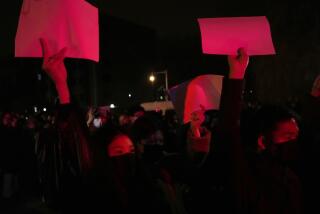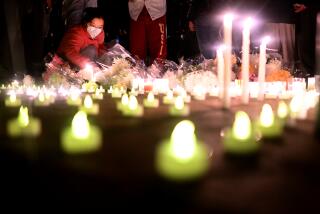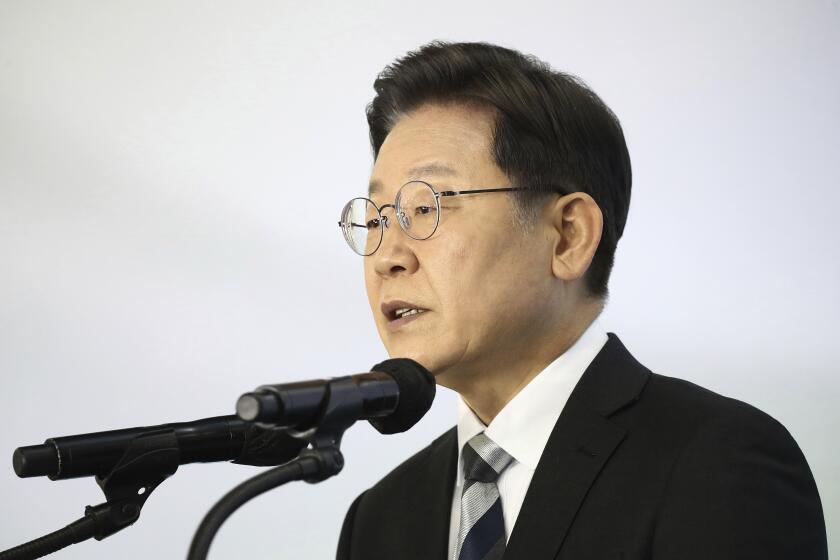Years of grievances erupt into rage
- Share via
BEIJING — Public schools Tibetans attend give short shrift to the Tibetan language, emphasizing Chinese instead. Ethnic Chinese hold most jobs, and Tibetan civil servants can be fired if their homes contain the traditional Buddhist shrine: a Buddha statue with incense sticks in front. Portraits of the Dalai Lama, the Tibetan leader who has been in exile since 1959, are prohibited.
Tibetans have compiled a long list of grievances since 1951, when the Chinese Communists seized control of their Himalayan-area homeland. Those grievances are the backdrop for the violence that has burst to the surface during the last week in protests across China and the world.
The Dalai Lama has repeatedly accused the Chinese of “cultural genocide,” suppressing language, faith and customs while simultaneously flooding traditional Tibetan territory with ethnic Chinese.
Less than half of what Tibetans consider their historic homeland lies within the bounds of what is now called Tibet in western China. The rest of these lands are within China’s Sichuan, Qinghai and Gansu provinces, where Tibetans are a minority and treated as second-class citizens.
“It is not a genocide like World War II, but there is just no attempt to preserve our culture,” said a 29-year-old student living in Beijing, who asked that her name not be used for fear that she could lose her residency permit.
The Chinese Communist Party says it has invested billions trying to lift what it calls a backward, feudal society into the 21st century. The most ambitious component of that investment was a $4-billion railroad extension that opened in 2006, linking the isolated Tibetan capital, Lhasa, to the rest of the country.
But Tibetans say that the Qinghai-Tibet rail line, billed as the highest in the world, had served only to bring more Chinese entrepreneurs, migrant workers and tourists into their lands, further diluting their culture.
The vast majority of the 4 million tourists who visited Tibet last year were Chinese, who are using their newfound wealth to experience what they see as China’s exotic “wild west.”
The hotels, travel agencies and restaurants they patronize are Chinese. Even many of the souvenir stalls selling traditional crafts in front of the main Jokhang Temple are owned by Chinese.
“All the jobs are held by Chinese. The businesses on the main square in front of the most sacred Tibetan temple are Chinese. You can imagine the resentment that generates and how it can manifest itself,” said Donald S. Lopez Jr., professor of Tibetan studies at the University of Michigan.
Although exact figures are hard to come by, Lhasa’s urban population of about 270,000 is already between 70% and 80% Chinese, said Kate Saunders, communications director for the London-based International Campaign for Tibet. She added that at least 100,000 migrant workers come from neighboring Sichuan province alone.
“The Sichuan dialect is now the most commonly heard in Lhasa, and there is a saying Lhasa is the backyard of Chengdu,” Saunders said, referring to the capital of Sichuan province.
“Although we have seen years of investment in Tibet, the vast majority of Tibetans are severely disadvantaged both socially and economically by inadequate education and healthcare so that they cannot compete with the growing number of Chinese migrants coming in,” Saunders said.
Tibet in the past was basically a theocracy with Buddhist monks not merely the spiritual leaders, but also the politicians, landlords and bankers. When the Communists arrived in the 1950s and confiscated the monasteries’ lands, they “threw Tibet into an economic chaos from which it still hasn’t recovered,” Lopez said.
The Cultural Revolution from 1966 to 1976 saw wide-scale destruction of the monasteries by the Red Guards and harassment of the monks.
Under Chinese paramount leader Deng Xiaoping in the 1980s, the monasteries were rebuilt and religious practice restored, but under tight supervision.
Chinese President Hu Jintao was named for a stint as Communist Party secretary for Tibet in 1988 and rolled back many of Deng’s reforms. His protege, the current party boss Zhang Qingli, is also said to have tightened regulations on the monks.
To this day, monks are forced to undergo what is called “patriotic education,” sitting through lectures by Communist Party cadres about China’s virtues and the dangers of religion. What most offends the monks is hearing tirades against the Dalai Lama and being forced to sign statements denouncing him.
The 72-year-old Dalai Lama is revered as a god-king by Tibetans, and insults toward him elicit a visceral response -- not unlike the violent response of some Muslims to perceived slights against Muhammad. In October, when the Nobel Peace Prize laureate was awarded a Congressional Gold Medal in Washington, Tibetan monks who tried to stage a celebration with fireworks were arrested.
Any Tibetan who wants to hold a civil service job must be careful not to be seen in processions or public religious celebrations.
“They say we can have religion. But if you practice religion, you won’t have a job,” said a 34-year-old Tibetan restaurant worker from Gansu province, who spoke on condition of anonymity.
Probably the biggest complaint of the Tibetans is the continued absence of the Dalai Lama. People fear that if he dies in exile, they will be left without spiritual or political leadership. In 1995, a 6-year-old boy considered a possible successor was detained by the Chinese, and his whereabouts are unknown.
As in many long-running ethnic conflicts, simmering grievances may explode over the most trivial incident.
Only last month, a riot broke out in Tongren, Qinghai province, after a Tibetan child bought a balloon from a Chinese Muslim merchant at the market. The balloon wafted away and the child demanded another for free. The merchant refused. Within a few hours, two police cars were burned and 20 people were hospitalized. A hundred people were arrested.
“Tibet is like a bomb,” said Tanzin Lama, a 25-year-old student from Qinghai province who fled in 1999 and now lives in London.
--
Times staff writer Ching-Ching Ni contributed to this report.
More to Read
Sign up for Essential California
The most important California stories and recommendations in your inbox every morning.
You may occasionally receive promotional content from the Los Angeles Times.













